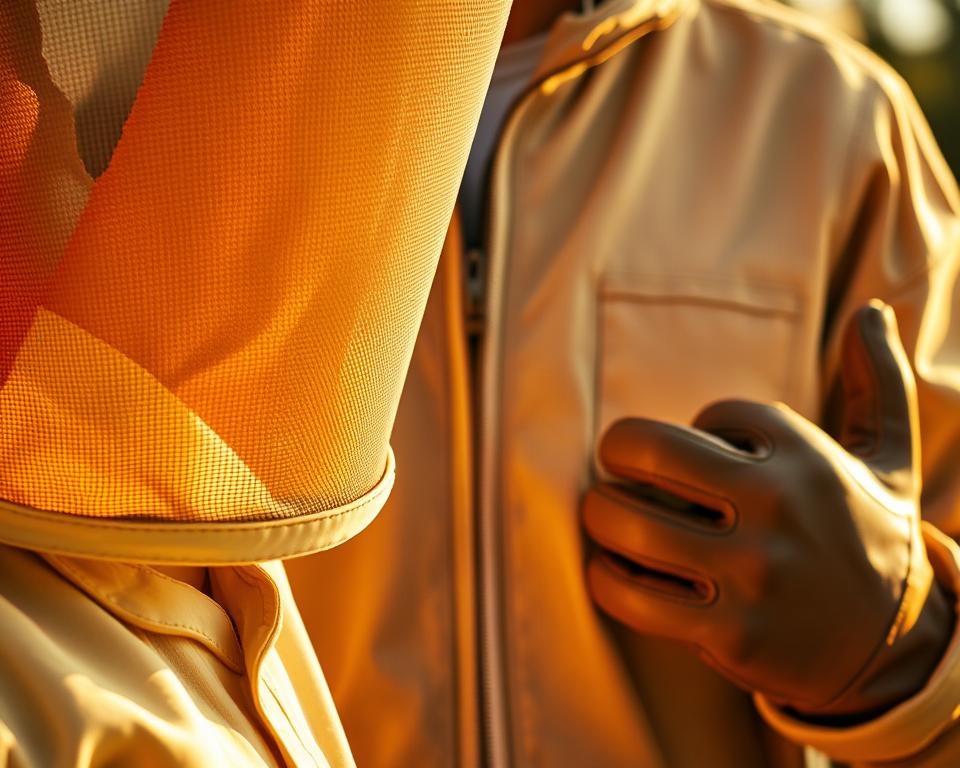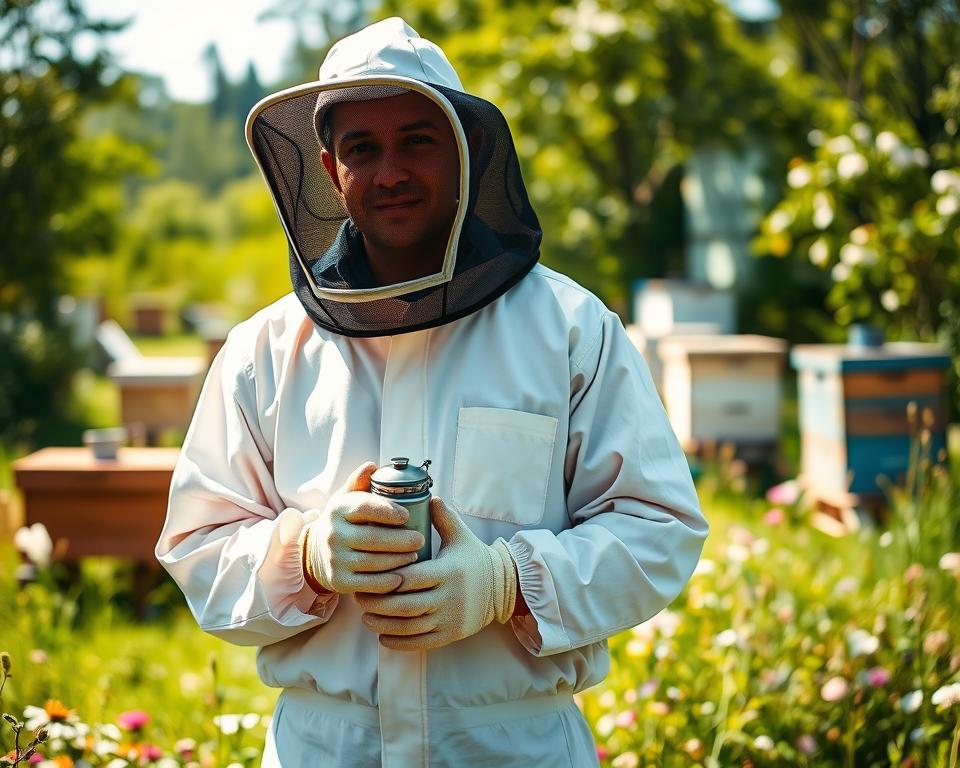When I started beekeeping, people often asked about safety. With over 89,000 bee stings reported in the U.S. each year, the right Beekeeper Suit is essential.
Having the right Apiary Safety Gear is key for a safe beekeeping experience. It protects you from bee stings and allergic reactions. This lets you enjoy the art of beekeeping.
Key Takeaways
- Essential beekeeping safety gear includes a beekeeper suit, veil, and gloves.
- A good beekeeper suit provides complete protection against bee stings.
- Choosing the right apiary safety gear makes your beekeeping experience better.
- Quality beekeeping protective gear is a smart investment for beekeepers.
- Proper safety gear lets beekeepers work confidently with bees.
Why Do You Need Beekeeping Protective Gear?
Having the right protective clothing is key for a good beekeeping experience. Bees can get aggressive if they feel threatened. Without protection, you risk getting stung.
Understanding Bee Behavior
Bees are usually calm, but they can get defensive when they feel their hive is in danger. Understanding bee behavior is important for safe beekeeping. For example, bees are more aggressive during certain times or when their hive is being checked. Wearing protective beekeeping clothing, like a beekeeping veil, can greatly lower the risk of stings.
“A beekeeper’s best friend is their protective gear, providing safety and confidence when inspecting beehives.”
The Risks Without Protection
Without proper protective gear, beekeepers risk getting stung. Bee stings can hurt and, in some cases, cause allergic reactions. The risks of not wearing protective gear include not just the immediate pain but also long-term health issues for those with allergies.
- Painful stings
- Allergic reactions
- Potential long-term health issues
How Protective Gear Enhances Safety
Protective beekeeping clothing, like bee suits and veils, is made to prevent bee stings. By wearing this gear, beekeepers can greatly reduce their risk of being stung. A beekeeping veil protects the face and neck, areas most at risk for stings.
Investing in quality beehive clothing is vital for any beekeeper. It not only boosts safety but also makes beekeeping more enjoyable. With the right protective gear, you can inspect your beehives with confidence.
Types of Beekeeping Protective Gear
Getting into beekeeping means knowing about protective gear. This gear keeps beekeepers safe from stings. It covers different body parts.
Bee Suits: A Must-Have
A Honey Bee Suit is key for beekeepers. It protects the whole body. It’s made from a material that lets you breathe and keeps bees out.
“The best beekeeping suits are those that balance protection with comfort,” says a seasoned beekeeper. “You want to be able to move freely without feeling too hot or restricted.”
Gloves: Keeping Your Hands Safe
Beekeeping Gloves are vital. They shield your hands from stings. Choose gloves that are tough but let you move your fingers well.
Veils: Protecting Your Face and Neck
A Bee Suit with Veil is a good choice. The veil guards your face and neck. It’s made from mesh that lets air in but keeps bees out.
Some beekeepers like veils with a stiff frame. This keeps the mesh away from their skin, lowering sting risk.
Footwear: Important Protection
Don’t forget about your feet. Bees can get in shoes. Wear boots or shoes that seal tight to stop stings on your feet.
- Choose boots that are comfortable and suitable for the terrain you’ll be working on.
- Consider boots with a smooth surface that bees can’t easily climb.
Choosing the Right Beekeeping Suit
Finding the right beekeeping suit is key to a safe and enjoyable beekeeping experience. When I started, I learned quickly that a good suit is essential. It keeps you safe and comfortable.
Fit and Comfort Considerations
A suit that fits well is important for both safety and ease of movement. Look for suits with adjustable cuffs and hemlines to keep bees out. Comfort is also vital, as beekeeping can take a while.
When trying on a suit, make sure it moves with you. A suit that’s too tight is restrictive. One that’s too loose may not protect you well.
Materials: Synthetic vs. Natural
Suits are made from different materials, each with its own benefits and drawbacks. Synthetic materials like polyester are durable and easy to clean. Natural fibers like cotton are breathable but may not last as long.
| Material | Durability | Breathability |
|---|---|---|
| Synthetic (Polyester) | High | Medium |
| Natural (Cotton) | Medium | High |
Essential Features to Look For
When picking a beekeeping suit, look for certain features. Ventilation is important to avoid getting too hot, which is more common in warmer weather. Also, suits with reinforced seams last longer.
- Elastic cuffs and hemlines for a secure fit
- Multiple pockets for storing tools and equipment
- A veil that provides clear visibility
By focusing on these features, you can find a suit that suits your needs and improves your beekeeping experience.
Essential Accessories for Beekeepers
Beyond the basics, several accessories can make beekeeping better. These tools improve safety and make bee care easier.
Bee Smoker: A Useful Tool
A bee smoker is key for beekeepers. It makes smoke that calms bees, helping you check the hive safely. Choosing the right fuel is important. For tips on using a bee smoker, check Mann Lake’s blog on essential equipment for.

Hive Tool: Maintenance and Safety
A hive tool is vital for many tasks. It helps open the hive and removes wax and propolis. It’s simple but very important for safety and upkeep.
First Aid Kit: Be Prepared
Even with care, accidents can happen. A first aid kit is essential for treating bee stings or minor injuries. Make sure it has antiseptic wipes, pain relievers, and any needed medications.
Adding these accessories to your routine boosts safety and efficiency. Beekeeping is about more than just the bees. It’s also about being ready with the right tools and gear.
Proper Maintenance of Protective Gear
Keeping your beekeeping gear in good shape is key. It’s important for your safety and enjoyment. I always make sure my gear is ready for the next beekeeping adventure.
Cleaning Your Bee Suit
It’s vital to clean your bee suit often. This stops bee pheromones from building up. They can attract bees and make them more aggressive.
Wash your suit in mild detergent and cold water. Don’t use bleach or fabric softeners. They can harm the fabric.
After washing, dry your suit properly. Hang it in a well-ventilated area, out of the sun. This keeps the fabric strong and protective.
Storing Your Gear Correctly
Storing your gear right is as important as cleaning it. Keep it in a dry, cool place, away from sunlight and moisture. This prevents damage and keeps it in good shape.
Use a storage bag or container made for beekeeping gear. They help keep your equipment clean and dry. Also, store it in a place where it won’t get crushed or damaged.
Checking for Damage
Always check your gear for damage. Look for tears, holes, or frayed seams in your suit, veil, and gloves. Replace any damaged gear to stay safe.
Also, check zippers, elastic, and other parts for wear. A quick check can help keep you safe while beekeeping.
| Maintenance Task | Frequency | Importance |
|---|---|---|
| Cleaning Bee Suit | After each use | High |
| Storing Gear | After each use | High |
| Inspecting for Damage | Before each use | High |
By following these tips, you can make your beekeeping gear last longer. A well-maintained Beehive Clothing is your best defense against bee stings.
“A beekeeper’s protective gear is only as good as its maintenance. Regular care ensures a safe and enjoyable beekeeping experience.”
When to Wear Protective Gear
As a beekeeper, knowing when to wear protective beekeeping clothing is key for a safe and fun experience. Whether you’re new or experienced, the right gear is vital.

First Time vs. Experienced Beekeepers
First-time beekeepers usually wear a honey bee suit because of their natural caution. But, even seasoned beekeepers should always wear protective gear. This is because you can never be too sure about your bees’ mood.
So, wearing protective gear is a habit that should last throughout your beekeeping career.
Handling Aggressive Bee Varieties
Some bees are more aggressive than others. When dealing with these bees, wearing protective beekeeping clothing is a must to avoid stings.
It’s important for beekeepers to know their bee species’ needs and behaviors. This helps them choose the best protective measures.
Seasonal Considerations
Seasonal changes can make bees more defensive. For example, when nectar is scarce, bees can get aggressive.
Knowing these seasonal changes and adjusting your gear can make beekeeping safer.
In conclusion, wearing protective beekeeping clothing, including a honey bee suit, is vital for all beekeepers. By understanding when to wear it, beekeepers can greatly reduce sting risks and enjoy a safer experience.
Popular Brands for Beekeeping Gear
The beekeeping gear market is full of brands, but some stand out. When choosing gear, look for brands known for quality, like Beekeeping Gloves and Bee Suit with Veil. It’s smart to check out different brands to see what fits your needs best.
Overview of Trusted Brands
Many brands are respected in the beekeeping world for their focus on quality and safety. Some top ones are:
- HoneyFlow
- Beekeeper’s Choice
- Apiary Gear
These brands have a wide range of products, from suits to gloves and veils. This means beekeepers can find all the gear they need.
Pros and Cons of Each Brand
Every brand has its good and bad points. For example, HoneyFlow is famous for its tough protective wear, like top-notch beekeeping gloves. Beekeeper’s Choice, on the other hand, is known for its comfy, customizable bee suits.
| Brand | Notable Product | Pros | Cons |
|---|---|---|---|
| HoneyFlow | Beekeeping Gloves | Durable, High-Quality | Higher Price Point |
| Beekeeper’s Choice | Customizable Bee Suit | Comfortable, Customizable | Limited Availability |
| Apiary Gear | Bee Suit with Veil | Comprehensive Protection, Affordable | Less Durable |
Customer Reviews and Ratings
What customers say is very important when picking beekeeping gear. Many praise HoneyFlow for its excellent customer service and long-lasting products. Beekeeper’s Choice gets thumbs up for its tailored options that meet personal needs.
Looking at the pros and cons of each brand and reading what others say can help you choose the right gear.
Common Mistakes to Avoid
Beekeeping is a rewarding hobby, but it comes with risks. Safety is key, whether you’re new or experienced.
Having the right protective gear is critical. I’ve seen many beekeepers skimp on quality, which is risky.
Skimping on Quality Gear
Investing in Beekeeping Protective Gear is vital. It may cost more upfront, but it saves you from stings and allergic reactions later. Cheap gear often lacks quality, making it less effective.
A bad bee suit can let bees sting you. Thin gloves can also make handling bees risky, leading to more stings.
Not Wearing Gear Consistently
Wearing Apiary Safety Gear consistently is essential. Many beekeepers don’t wear it every time, even if they’re experienced. Bees can be unpredictable.
Wearing gear all the time helps you stay safe. It makes you comfortable and confident around your bees.
Neglecting Maintenance
Many beekeepers forget to maintain their gear. Cleaning and inspecting your equipment regularly is important. Neglecting this can make your gear less effective.
For example, not cleaning your bee suit can cause skin irritation. Regular checks and proper storage can keep your gear in good shape.
In summary, avoiding these mistakes can make beekeeping safer and more enjoyable. Quality gear, consistent use, and maintenance are key to a safe beekeeping experience.
Conclusion: Invest in Your Safety and Enjoyment
As we finish talking about beekeeping protective gear, it’s clear that the right equipment is key. A good Beekeeper Suit and Beekeeping Veil are vital. They protect you from bee stings and let you enjoy your beekeeping.
Key Takeaways
Remember, picking the right beekeeping suit is important. Also, keep your gear in good shape and know when to use it. These tips help you stay safe and have fun with beekeeping.
Gear Up for Success
I suggest using what you learned in this article for your beekeeping. Getting a quality Beekeeper Suit and Beekeeping Veil is a smart move. It keeps you safe and makes beekeeping more enjoyable.
Safety First
Beekeeping safety is a top priority. With the right gear, you can enjoy this hobby without worry. Focus on your safety and use the right protective gear for a great beekeeping experience.
